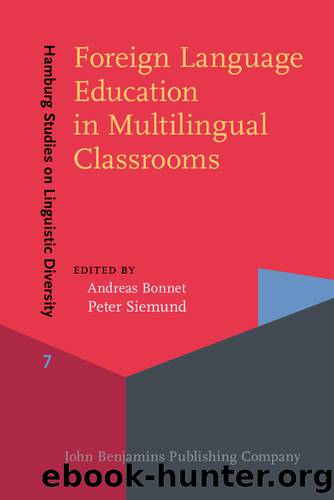Foreign Language Education in Multilingual Classrooms by Bonnet Andreas;Siemund Peter; & Peter Siemund

Author:Bonnet, Andreas;Siemund, Peter; & Peter Siemund [Bonnet, Andreas & Siemund, Peter]
Language: eng
Format: epub
Publisher: John Benjamins Publishing Company
Published: 2018-10-08T14:11:15+00:00
4.2Monoglossic and heteroglossic perspectives
It should be acknowledged that a common strand regarding the promotion of individual multilingualism is still embedded in powerful monolingual ideologies, and that the âmultilingual imperativeâ is crossed by different tensions. Indeed, language education is being challenged by the idea that linguistic borders are fluid and unsuitable, or at least insufficient, to explain linguistic phenomena or communication in super-diverse contexts (Canagarajah 2013; Makoni & Pennycook 2007). Even if many pedagogical practices and curricular changes in language education already challenge monolingual norms (by dealing with different languages, dialects or varieties), as we saw previously, a critical posture may be essential to advance towards a more heteroglossic and combined use of linguistic and other semiotic resources across the curriculum and in the classroom. Heteroglossia has been proposed as âa means of expanding theoretical orientations to, and understanding of, linguistic diversityâ (Blackledge & Creese 2014:â¯1), offering a powerful lens to understand the several dimensions of language in practice: ârather than assuming that homogeneity and stability represent the norm, mobility, mixing, political dynamics, and historical embedding are now central concerns in the study of languages, language groups, and communicationâ (ibid.; see also Bailey 2012). In terms of classroom interaction in the foreign language, for example, this means that communication should move away from a perspective that seeks to ascribe students to an exclusive language (learner) identity and embrace another one that sees them as creative language users (Busch 2014). Such a perspective recognizes that students employ their full range of semiotic resources, not only to acquire further features of another language but also to achieve their communicative needs to the best of their ability, in what has recently been called âtranslanguagingâ (GarcÃa & Wei 2014), both as a practice and a pedagogy.
Heteroglossia in the classroom, as a pedagogical, intersubjective and co-responsible approach to language education, thus implies three core principles (Busch 2014): multidiscursivity (learners can bring their concerns and topics of interest and participate in the hic et nunc construction of the classroom discourse), multivoicedness (learning is multidirectional and teaching and learning roles are not given in advance but situationally conveyed) and legitimacy of multiple codes (translanguaging as a transsemiotic meaning-making and meaning-negotiation process). These core principles, as we will see, are hard to operationalize in concrete curricular options.
In way of an example, the bilingual pre-primary schools under research in many projects included in Mourão and Lourenço (2015) follow a âtwo solitude modelâ principle (see Cummins 2008 for a critique), or a monolingual immersive program, and privilege native speakers (namely English native speakers) as models of linguistic and cultural authenticity, thus allowing little space for the emergence of multiple codes. These principles, as well as much of the research carried out, suffer from a monolingual and monoglossic bias, or a âmonolingual research habitusâ, following Gogolin (2008), as the importance given to native and monolingual norms reduce the core values of intercultural and multilingual competence that acknowledge individual and social variation, as well as diversity and hybridity. Such programs also fail to
Download
This site does not store any files on its server. We only index and link to content provided by other sites. Please contact the content providers to delete copyright contents if any and email us, we'll remove relevant links or contents immediately.
Cecilia; Or, Memoirs of an Heiress — Volume 1 by Fanny Burney(32432)
Cecilia; Or, Memoirs of an Heiress — Volume 2 by Fanny Burney(31865)
Cecilia; Or, Memoirs of an Heiress — Volume 3 by Fanny Burney(31849)
The Lost Art of Listening by Michael P. Nichols(7403)
Asking the Right Questions: A Guide to Critical Thinking by M. Neil Browne & Stuart M. Keeley(5627)
We Need to Talk by Celeste Headlee(5542)
On Writing A Memoir of the Craft by Stephen King(4862)
Dialogue by Robert McKee(4321)
Pre-Suasion: A Revolutionary Way to Influence and Persuade by Robert Cialdini(4142)
I Have Something to Say: Mastering the Art of Public Speaking in an Age of Disconnection by John Bowe(3838)
Elements of Style 2017 by Richard De A'Morelli(3306)
The Book of Human Emotions by Tiffany Watt Smith(3235)
Fluent Forever: How to Learn Any Language Fast and Never Forget It by Gabriel Wyner(3024)
Name Book, The: Over 10,000 Names--Their Meanings, Origins, and Spiritual Significance by Astoria Dorothy(2938)
Good Humor, Bad Taste: A Sociology of the Joke by Kuipers Giselinde(2900)
Why I Write by George Orwell(2874)
The Art Of Deception by Kevin Mitnick(2734)
The Grammaring Guide to English Grammar with Exercises by Péter Simon(2706)
Ancient Worlds by Michael Scott(2621)
